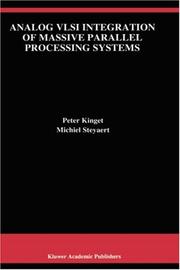| Listing 1 - 2 of 2 |
Sort by
|

ISBN: 0792398238 9780792398233 1441951687 1475725809 Year: 1997 Publisher: Boston: Kluwer,
Abstract | Keywords | Export | Availability | Bookmark
 Loading...
Loading...Choose an application
- Reference Manager
- EndNote
- RefWorks (Direct export to RefWorks)
When comparing conventional computing architectures to the architectures of biological neural systems, we find several striking differences. Conventional computers use a low number of high performance computing elements that are programmed with algorithms to perform tasks in a time sequenced way; they are very successful in administrative applications, in scientific simulations, and in certain signal processing applications. However, the biological systems still significantly outperform conventional computers in perception tasks, sensory data processing and motory control. Biological systems use a completely dif ferent computing paradigm: a massive network of simple processors that are (adaptively) interconnected and operate in parallel. Exactly this massively parallel processing seems the key aspect to their success. On the other hand the development of VLSI technologies provide us with technological means to implement very complicated systems on a silicon die. Especially analog VLSI circuits in standard digital technologies open the way for the implement at ion of massively parallel analog signal processing systems for sensory signal processing applications and for perception tasks. In chapter 1 the motivations behind the emergence of the analog VLSI of massively parallel systems is discussed in detail together with the capabilities and !imitations of VLSI technologies and the required research and developments. Analog parallel signal processing drives for the development of very com pact, high speed and low power circuits. An important technologicallimitation in the reduction of the size of circuits and the improvement of the speed and power consumption performance is the device inaccuracies or device mismatch.
Linear integrated circuits. --- Parallel processing (Electronic computers) --- Signal processing --- Neural networks (Computer science) --- Circuits intégrés linéaires --- Parallélisme (Informatique) --- Traitement du signal --- Réseaux neuronaux (Informatique) --- Digital techniques. --- Techniques numériques --- Linear integrated circuits --- Digital techniques --- Neural networks (Computer science). --- Parallel processing (Electronic computers). --- Electrical engineering. --- Statistical physics. --- Dynamical systems. --- Signal processing. --- Image processing. --- Speech processing systems. --- Electrical Engineering. --- Complex Systems. --- Signal, Image and Speech Processing. --- Statistical Physics and Dynamical Systems. --- Computational linguistics --- Electronic systems --- Information theory --- Modulation theory --- Oral communication --- Speech --- Telecommunication --- Singing voice synthesizers --- Pictorial data processing --- Picture processing --- Processing, Image --- Imaging systems --- Optical data processing --- Processing, Signal --- Information measurement --- Signal theory (Telecommunication) --- Dynamical systems --- Kinetics --- Mathematics --- Mechanics, Analytic --- Force and energy --- Mechanics --- Physics --- Statics --- Mathematical statistics --- Electric engineering --- Engineering --- Statistical methods --- Digital signal processing --- Digital communications --- Digital electronics --- Linear ICs --- Analog integrated circuits --- High performance computing --- Multiprocessors --- Parallel programming (Computer science) --- Supercomputers --- Signal processing - Digital techniques
Book
Year: 1997 Publisher: Boston ; Dordrecht ; London Kluwer Academic Publishers
Abstract | Keywords | Export | Availability | Bookmark
 Loading...
Loading...Choose an application
- Reference Manager
- EndNote
- RefWorks (Direct export to RefWorks)
| Listing 1 - 2 of 2 |
Sort by
|

 Search
Search Feedback
Feedback About UniCat
About UniCat  Help
Help News
News